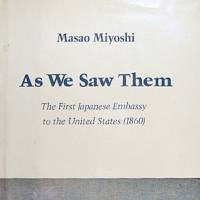In "As We Saw Them," literary critic and academic Masao Miyoshi looks at the 1860 Japanese embassy to the United States, the first sent to a Western power after centuries of seclusion.
As We Saw Them, by Masao Miyoshi
243 pages
University of California Press, Nonfiction.
Miyoshi then focuses on the embassy's two outliers: vice ambassador Muragaki Norimasa and chief ambassador's servant Tamamushi Yasushige. Muragaki interprets everything he sees as a confirmation of "American barbarism," while Tamamushi is optimistic about foreign customs. Having demonstrated intellectual diversity within the Japanese ranks, Miyoshi widens his scope to include Townsend Harris, the first U.S. Consul General to Japan. He dramatically contrasts Harris' description of meeting the shogun alongside Muragaki's reflections on meeting the U.S. president.
It is painful to read Miyoshi's exacting descriptions of how ignorant the Japanese and Americans were of each other. It can seem unclear if either the ambassadors or their hosts learned anything at all from the encounter, but Miyoshi convincingly argues that cultural currents shaping U.S.-Japan relations today can be found here, "at the dawn of modern Japan."
Read archived reviews of Japanese classics at jtimes.jp/essential.


















With your current subscription plan you can comment on stories. However, before writing your first comment, please create a display name in the Profile section of your subscriber account page.